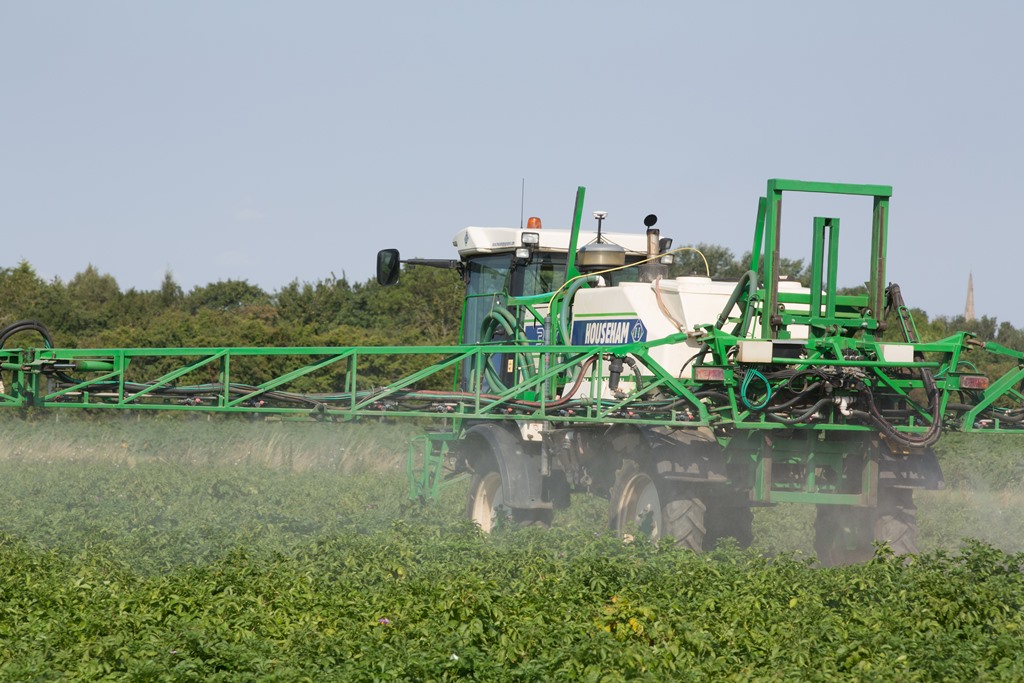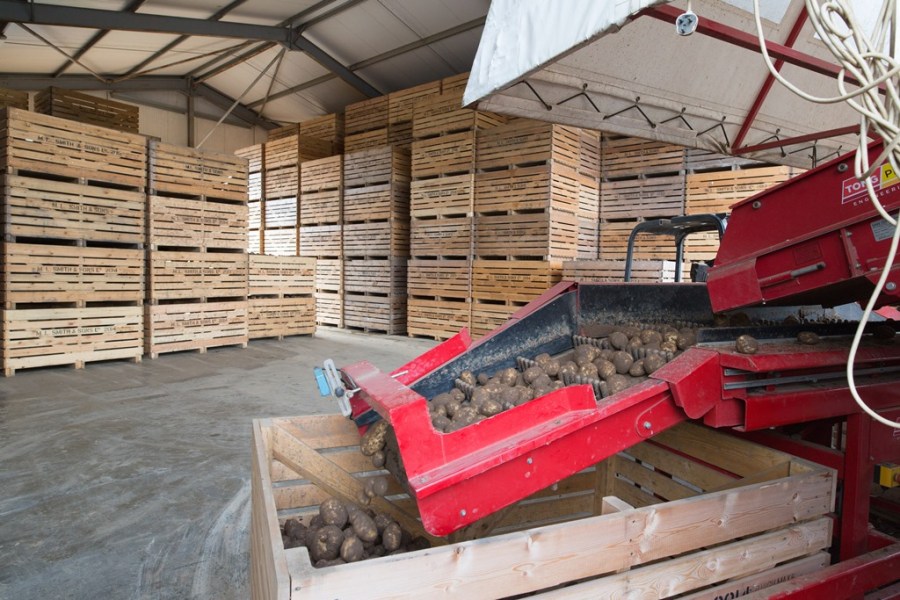For many growers the potato harvest of 2020 marks a step into the unknown when it comes to store management. The gap left by CIPC (chlorpropham) and the long-lasting sprout suppression it gave isn’t one that’s easily filled and requires a more integrated approach. CPM digs deeper.
Processing growers are likely to face particular difficulties.
By Lucy de la Pasture
AHDB has been considering an integrated strategy for managing sprouting in stores since the future of CIPC first looked to be in jeopardy in 2007 and the CIPC Stewardship Group was first formed, explains Adrian Briddon, based at AHDB’s Sutton Bridge Crop Storage Research in Lincolnshire.
“An integrated approach to managing sprouting in potatoes means considering it from every angle. That includes making use of varietal factors that can help reduce reliance on chemical sprout suppression – such as inherent dormancy characteristics and cold-temperature tolerance – and store management practices to minimise any variation within stores.”
The problem is particularly acute for the processing sector, where storage at warmer temperatures means it’s more of an uphill battle to maintain dormancy during storage. Meeting regulations adds an extra dimension to the storage problem, explains Adrian.
“Growers who are able to hold processing varieties at a slightly lower temperatures than normal (6⁰C) also have to be mindful of cold-sweetening so that they meet acrylamide regulations when potatoes come out of storage.”

AHDB trials have shown that maleic hydrazide application to the growing crop can form a good foundation for sprout suppression in store, as long as adequate uptake is achieved.
AHDB initiated several research projects in 2018 in anticipation of CIPC’s removal. The aim has been to provide independent data to growers to help develop sprout suppression strategies using the alternative chemistry that’s currently available, while also assessing the active ingredients in the pipeline. It has also addressed the fundamental question of dormancy and, in particular, the different dormancy characteristics of varieties, adds AHDB’s Dr Glyn Harper.
“The market remains the major factor driving variety decisions on farm and most growers have extensive knowledge about how best to store familiar varieties. For instance, King Edward’s are notorious for early dormancy break, so growers know to either sell early, keep cold or manage with an effective sprout suppressant.
“Russet Burbank and Markies are known to have a longer dormancy but because they are processing varieties, storage has to be at warmer temperatures (7-8⁰C), so sprouting can still be an issue.”
But when it comes to considering changing to a new variety, independent data on variety dormancy is scarce and sometimes conflicting. In an era without CIPC, sprout suppression has become a more costly and management-intensive process so better information on dormancy would enable growers to plan storage regimes and duration better, believes Glyn.
In an attempt to fill this knowledge gap, an AHDB project is now in its third season and aims to provide a dormancy ranking for around 40 commonly grown potato varieties. Dormancy varies widely in different potato varieties and is governed by genetic factors, tuber initiation and multiple physiological and environmental factors during crop growth and storage.
“Biologically the dormancy of tubers is set at the point of tuber initiation, which again is not easily measured. The visual marker for tuber initiation in the field is 50% emergence but can also be measured from the date of harvest.
“We can’t measure the actual moment of dormancy break in a potato, but sprout growth gives a visible cue that dormancy break has occurred. So for the purposes of the trial we defined dormancy break when 50% of tubers had sprouts of 3mm and recorded the period of time from either tuber initiation or harvest to dormancy break in all the varieties in the trial,” explains Glyn.
The dormancy ranking trial series has had its share of challenges, with the second year standing out as the only one where the full range of varieties was included at two different sites.
“In its first year the project was too late to set up its own trial site, but we were able to take advantage of untreated plots in a herbicide variety trial at SPot farm North, which provided us with 20 different varieties.
“In 2018-19 the trial was expanded to 40 varieties replicated at two sites, SPot North and SPot West, with a further eight varieties added at the SPot West trial site.”
In 2020 COVID-19 has thrown a curved ball and the resulting lockdown curbed a repeat of the trials planned for the SPot locations. Luckily the trial was saved when potato grower Mark Means offered Sutton Bridge a more local site so 23 varieties were able to be planted in a small plot trial.
In spite of the difficulties, Glyn is confident that the three years of work will provide some useful data because there has been some continuity in the trials, but he would like to see the project extended so the that the work can repeated over two sites with the full suite of varieties.
“This would give us full control over the planting material so we’d be able to minimise some of the variations that can influence the results which would provide more robustness to the data,” he adds.
So far the trials have thrown up some anomalies which the researchers are finding hard to explain. “In the 2018/19 trial, there were some atypical results in some varieties, with different dormancy at the different sites. The seed was drawn from the same stock for both sites and there was no clear site effect across the whole trial.
“Desiree had a longer dormancy than expected but the results were identical at both trial sites. It’s not something we can readily explain but is possibly due to a complex interaction between site, tuber initiation and maturity,” suggests Glyn.
While better information on varietal dormancy may help growers with planning storage, managing sprouting is a process that now starts in the field with application of maleic hydrazide (MH), highlights Adrian.
MH is now seen as the foundation for successful sprouting control in storage, so an AHDB project is attempting to better understand the uptake and performance in varieties grown for the processing and prepack markets.
“A benefit was seen from MH application across the trial, with some variations in effectiveness between varieties. Differences occur in uptake (perhaps an unexpected rain shower) resulting in lower residue values, but we still see a benefit from this in sprout control,” he explains.
“It’s clear from our results that MH can effectively reduce the need for post-harvest treatments if there is enough MH residue in tubers. Because it’s systemic MH can have a long-lasting effect and when its applied to a variety with a relatively high dormancy the result can be very little intervention is required to stop sprouting in-store.”
The MH work was repeated with Maris Piper, Melody, Nectar and King Edward – selected to represent popular varieties in the fresh sector with a range of relative dormancy characteristics, adds Glyn.
“We found MH gave a good foundation for sprout control. Once inside the tuber MH doesn’t dissipate, which provides a persistent effect when tubers come out of cold storage and on to the shelf, giving 10-14 days shelf life at 12⁰C.
“MH also has a useful effect during store loading when the storage temperature can’t be pulled down to optimal levels, particularly in short dormancy varieties such as King Edwards,” he explains.
The loss of CIPC has the biggest impact on the processing sector, where store temperature has to be maintained at a higher temperature than for the fresh market. AHDB has been assessing the efficacy of the alternatives to CIPC, with and without MH, and noting any adverse effects on fry colours.
“All the alternative sprout suppressants are volatile so they don’t last as long in stores, whereas CIPC was long-lived. This means store checking will need to be more frequent and the number of post-harvest applications required will be greater, with a dose rate in some products that may change during storage,” explains Adrian.
Products with current approval include ethylene and spearmint oil (Biox-M) but the trials are also looking at near market products which could expand the range of sprout suppressants available. CRD are thought to be nearing a decision on the long-awaited actives 1,4-dimethylnapthalene (DMN) and orange oil. A further active, 3-decen-2-one, is also going through the European approval process.
In the processing varieties looked at, spearmint oil was the most effective of the currently approved treatments, but results were influenced by variety, explains Adrian.
“Sprout length was controlled to 12-20mm in Maris Piper, Innovator, Royal and Performer but control was better in VR808, with a mean sprout length of 8mm.”
Ethylene was more effective at controlling sprout length in Maris Piper and VR808 (sprouts 5-10mm), but results were very dependent on variety. Some effects on fry colour have been noted but these are usually slight and temporary.
Best of all the treatments was DMN which has led AHDB to apply for its emergency authorisation for this season.
“Processing growers are likely to face particular difficulties without access to CIPC, particularly for long-term storage of crisping varieties and DMN would provide a more effective and less risky means of controlling sprouting than the currently available actives,” comments Adrian.
DMN and spearmint oil also performed well in the pre-packing varieties trial, with effective sprout control over a nine-month storage period in both long and short dormancy varieties.
“CIPC was a one treatment solution and was very good at what it did. We now need to factor in all the elements that can affect sprouting in store and learn how best to integrate them cost-effectively and for best effect. In the medium to long term this is likely to drive some varietal change,” he concludes.
Storage research is invaluable to the industry
Potato agronomy has needed an increasingly integrated approach over the past few years as the industry has coped with the successive loss of crop protection products. Potato storage will need the same ‘mix and match’ approach, says Jeff Beever, agronomist for McCain Foods (GB) Ltd and chair of the Potato Processors’ Association Primary Production technical committee.
There’s little doubt that the approval of DMN would give growers the flexibility they need to manage potatoes in longer-term storage and Jeff is disappointed that the long wait continues. While he fully supports the application for emergency approval lodged with CRD, there are caveats to its use within the application which will narrow its field of use so it’s not quite the same as a fully approved product, he points out.
“DMN is approved in 15 different EU countries and a number of others are likely to grant approval this year. France and Ireland have livestock feeding restrictions attached but this isn’t stewarded. That means there isn’t a level playing field with the EU. It’s possible to import DMN treated tubers, sell potatoes or potato products to consumers, and feed the waste to livestock without restriction.”
The emergency approval if granted, will have varietal and livestock feeding limitations, says Jeff. It will also require potatoes to be in long-term storage and tubers must have MH residue levels of below 12ppm before they can be treated with DMN, adding a small cost to growers (c£40-45 per sample).
Even with these caveats, in the absence of the full authorisation for this season, an emergency approval would be a welcome addition to the current options of ethylene and spearmint oil. McCain made the decision four years to go primarily down the ethylene route and have so far had no problems with the 100,000t that have been treated, says Jeff.
“We have processed everything. We have seen a small shift in fry colour in some varieties, but we are able to blanch potatoes which restores it so it’s an effect that can be managed.”
The situation isn’t as straight forward for crisping varieties as blanching isn’t an option, he says, so in the absence of DMN, spearmint oil will currently be the likely product of choice.
Jeff believes AHDB-funded storage research is absolutely critical to the industry. “Sutton Bridge has been carrying out valuable work over the years and it’s more critical than ever that we have a good storage research facility in the UK. There’s a very strong need for potato storage research that’s available to the whole industry.
“The work being done there on the alternatives to CIPC is extremely valuable, particularly as there is no commercial experience of the pipeline products. Sprout suppression has become more complex so we need to gain knowledge on how active ingredients can be used in sequence through the season for the best effect,” he concludes.
Research roundup
AHDB Project No 11140043 ‘Alternative sprout suppressants (processing)’ runs from July 2017 to June 2020 at a cost of £243,000, in collaboration with Dormfresh, Xeda, Restrain and UPL (Arysta).
AHDB Project No 11140057 ‘Integrating alternative sprout suppressants for the fresh market runs from July 2018 to June 2021 at a cost of £264,000, in collaboration with Dormfresh, Xeda, Restrain and (UPL) Arysta.
AHDB Project No 11140058 ‘Understanding dormancy rankings in potatoes’ runs from Oct 2018 to September 2021 at a cost of £75,000, in collaboration with NRI.
AHDB Project No 11140056 ‘Using maleic hydrazide as a sprout suppressant’ runs from October 2018 to June 2021 at a cost of £100,000, in collaboration with UPL (Arysta).
From Theory to Field is part of AHDB’s delivery of knowledge exchange on grower-funded research projects. CPM would like to thank AHDB for its support and in providing privileged access to staff and others involved in helping put these articles together.




